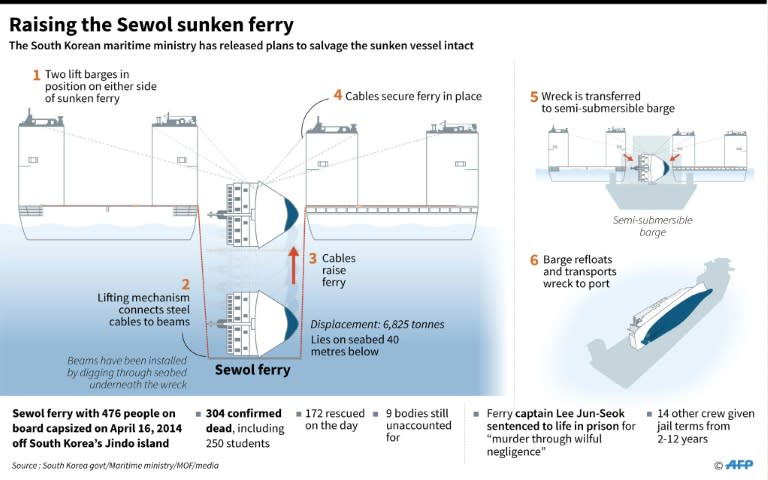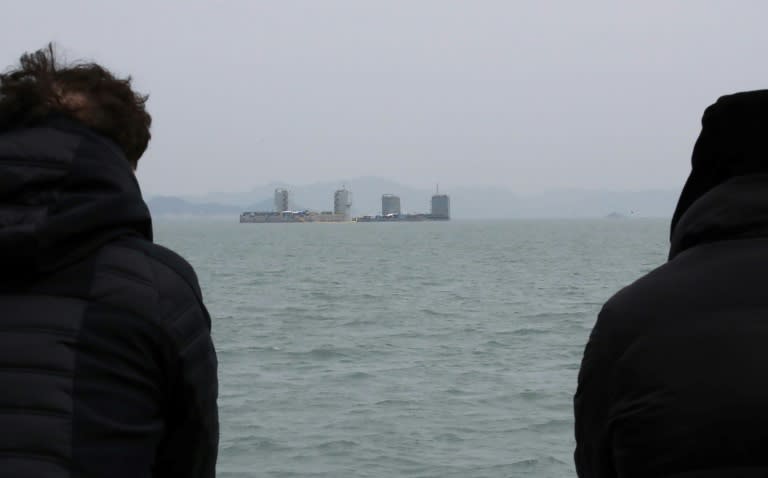South Korea raises sunken Sewol ferry
South Korea’s sunken Sewol ferry emerged from the waters Thursday, nearly three years after it went down with the loss of more than 300 lives and dealt a crushing blow to now-ousted president Park Geun-Hye. Television pictures showed one side of the 145-metre-long vessel, its white structure rusted and filthy, above the waves between two giant salvage barges. The complex operation -- one of the largest raisings of an entire ship ever attempted -- comes as the third anniversary approaches of one of the country's worst-ever maritime disasters. Almost all the dead were schoolchildren and it is thought that nine bodies still unaccounted for may be trapped inside the sunken ship. Raising the ferry intact has been a key demand of the families of the victims. Several relatives watched the much-anticipated operation unfolding from a boat near the site. "To see the Sewol again, I can't describe how I'm feeling right now," said Huh Hong-Hwan, whose 16-year-old daughter was killed in the accident. Her body has not been found. Huh and his wife have for years maintained a bitter, defiant vigil in Jindo along with a handful of other relatives of missing victims. "It took so long," Huh said. Another parent, Lee Keun-Hui, tearfully called for public support and prayers to help move the ship onshore intact and a full inquiry into the sinking "so a tragedy like this would never ever happen again". "It breaks my heart to see the ship coming up," she said. "My daughter has been trapped in such a dirty, dark place for all these years." Other bereaved family members have kept watch at a camp on a hilltop on Donggeochado -- the nearest island to the site, just 1.5 kilometres (a mile) away. About 450 workers are involved in the painstaking efforts to lift the ship, which has a displacement of 6,825 tonnes but is now estimated to weigh between 8,000-8,500 tonnes including the silt piled up inside. Dozens of salvage operators walked over the hull after it came to the surface, television pictures showed. By late evening, the top of the wreck was 10 metres above the waterline, Seoul's maritime ministry said in a briefing. The salvage operators were cutting off the ramp of the Sewol which was open and hampering the operation, the ministry said, ending the government's goal of lifting the wreck in one piece. Once it is raised to 13 metres, the ferry will be moved onto a semi-submersible ship, which will carry it to the port of Mokpo. "We believe that it will take about 12 to 13 days to lift the ship and move it to Mokpo," said Lee Cheol-Jo, the ministry official in charge of the operation. The vessel was lying more than 40 metres (130 feet) below the waves off southwestern South Korea and the operation, originally scheduled for last year, had been pushed back several times because of adverse weather. - Protest site - The Sewol sinking left the country deeply traumatised, and a steady stream of citizens made their way Thursday to a memorial altar on Jindo to pay their respects to the ferry victims, bowing and placing white chrysanthemums before a wall of photos of the young victims. "It's very sad," said Kim Joong-Pyo, his voice cracking with emotion."I hope they find all the children." The disaster was a crippling blow to the now-ousted leader Park Geun-Hye, whose dismissal over a corruption scandal was confirmed by Seoul's top court only two weeks ago. She stayed at her residence for the first few critical hours after the disaster while officials were frantically sending updates and asking for guidance. She has never specified what she was doing for the seven hours, sparking wild rumours including a tryst and cosmetic surgery. A permanent Sewol protest site targeting her was subsequently set up in the centre of Seoul, with effigies of the head of state on display alongside pictures of the dead schoolchildren. Investigations into the disaster, in which 304 people died, concluded it was largely man-made -- the cumulative result of an illegal redesign, an overloaded cargo bay, inexperienced crew and a questionable relationship between the ship operators and state regulators. Even though the vessel took around three hours to sink, many of those on board never heard any evacuation order, while the crew were among the first to escape to safety. Captain Lee Jun-Seok was sentenced to life in prison for "murder through wilful negligence" and 14 other crew members were given terms ranging from two to 12 years.




